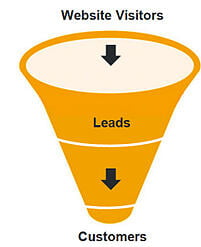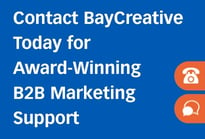But too often, companies leave their underperforming website on staff rather than invest the time and effort in building a better website. So the website sticks around, its behavior basically unchanged for years.
And that’s a mistake.
No matter the size of your business, a modern, optimized B2B website is essential for finding those prospects who are seeking your solutions, to help establish your presence in the marketplace, to extend your reach, and to help decision-makers select and buy your products and/or services.
If your website isn’t doing those things for you, it might be time for a redesign. B2B website best practices are evolving constantly, and your website needs to evolve with them.
In this post, we’re offering some best practices for when you do redesign your site.
- These days, you have to have a responsive design to your B2B website, meaning it automatically adjusts the layout to the device it’s being viewed on. That way, your website will have a mobile-first feel to it. Also, write your on-page content for mobile devices—keep it concise and break it up with white space and bullet points.
- Your B2B website needs to be search engine optimized so it appears high in the list of results when a prospect looks for your product/service on an online search engine. SEO has been a staple of websites from the beginning. But, like website design best practices, it’s constantly evolving; that means you have to constantly be re-approaching your site content and off-site SEO factors.
- Related to that is the need for consistent, quality content on your B2B website. A good website is more than just a storefront with a list of products. By including regular blog posts and other content such as case studies and white papers, you turn your website into a library of content that showcases your knowledge.
- When you think about content for your B2B website pages, don’t just fixate on text. Include compressed video, pictures, infographics, and more. Be sure to fill in the alt tag and description boxes for those content pieces, because that will help with SEO, as well.
- Use consistent messaging throughout your B2B website.
- Keep navigation easy. Set it up so that the end user can reach any page within three clicks, make the path to that final destination clear, and ensure the user has clear choices and can easily get to where they want to go within your site.
- Don’t load your B2B website up with plug-ins and large photo and video files that bog down load times. The longer the page takes to load, the more likely the visitor will grow impatient and leave the page.
- Put a clear call to action (CTA) on every page, preferably on the top half of the page. Don’t leave visitors wondering what to do next.
- Continue to maintain, update, and analyze your B2B website to ensure it continues to work for you.
Our biggest recommendation for creating an effective B2B website? Work with an established website design company that knows what it’s doing. The above list doesn’t begin to scratch the surface of best practices, but the right agency will know all the tricks for building a website that brings eyes to your site and increases conversion rates.
BayCreative is one such agency. We’re a full-service B2B marketing/branding/creative agency based in San Francisco but we have clients across the United States... many of whom we’ve worked with to create great websites.
For more tips, download our FREE eBook, “ 7 Steps for Successful Website Redesigns ."





